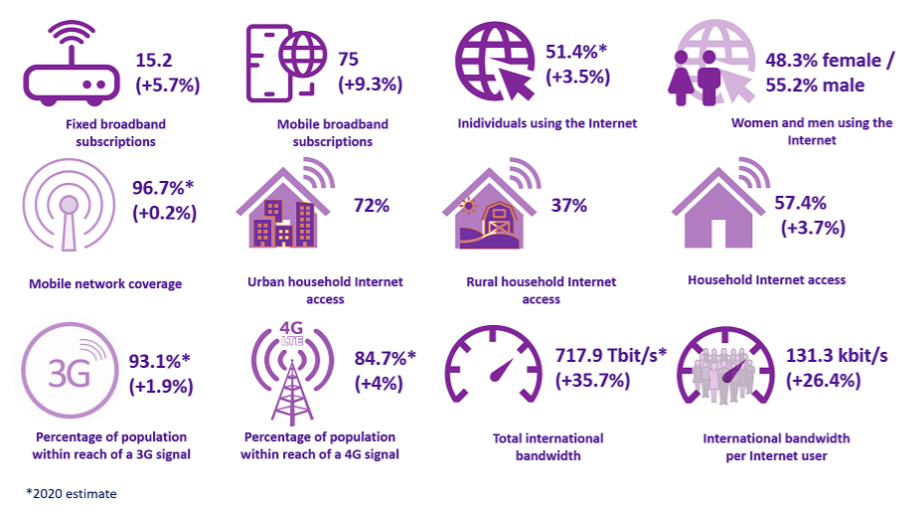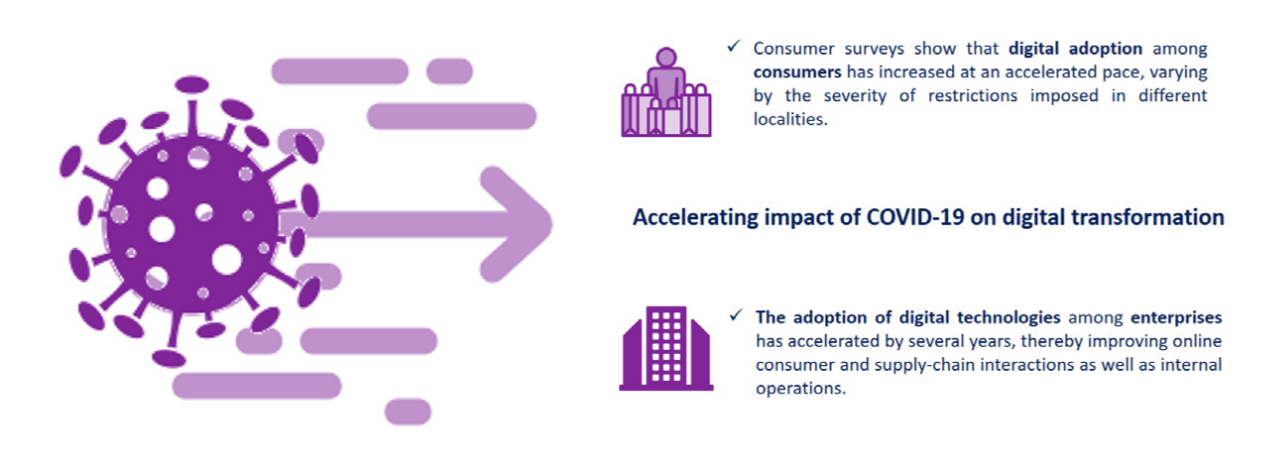


Nissrine Fessikh
13-10-2021 5 min readThe ongoing development of digital transformation in Asia-Pacific
While COVID-19 dominated headlines throughout 2020, the continued development and deployment of information and communication technology (ICT) infrastructure and its concomitant services has led to a continuing trend toward digital transformation for corporations, businesses, and governments. Since the last World Telecommunication Development Conference in 2017 (WTDC-17), ICT has continued to spread. ITU data shows that in 2019, internet usage passed the 50% mark (51.4% globally by the end of 2019), 75%of the total global population had an active mobile broadband subscription, and fixed broadband subscriptions increased to just over 15%. Today, more than 57% of households have Internet access at home.
Furthermore, with the increase in data demand due to increasingly bandwidth-intensive services, international bandwidth has, on average, grown at a compound annual growth rate (CAGR) of 36% between 2017 and 2020, with a CAGR for international bandwidth per Internet user of 26% between 2017 and 2019. Yet the digital divide persists.
While almost every urban area in the world is covered by a mobile broadband network, many gaps persist in rural areas. The gender gap remains a reality, with even fewer women than men taking advantage of Internet use.

Global ICT indicators per 100 population/per cent (where applicable), 2019 and 2020, and compound average annual growth rate (CAGR) (where applicable), 2017-2019/2017-2020.
As most countries around the world grapple with the effects of the COVID-19 pandemic, the role of ICT and digital services and the digital infrastructure on which they depend have become critical to continued economic and social activity and to reducing the impact of the pandemic. The ITU's June 2020 roundtable of economic experts concluded that countries with advanced connectivity infrastructure could mitigate up to half of the negative economic impact of the pandemic. One response to the pandemic has been to accelerate digital transformation, as companies move toward digital employment and delivery models for services and products.
Individuals are forgoing travel and socialization, and are turning to digital entertainment and communication platforms and, increasingly, to e-commerce.
Schools are moving to online learning and digital classrooms, and governments are increasingly relying on data, citizens, health and economic indicators to set policy. While research on the contribution of digitization to mitigating the impact of pandemics is limited, the emerging evidence is compelling about its accelerating effect in all areas of people's lives and in all sectors of the economy. For example, surveys show that the COVID-19 pandemic pushed consumers and businesses to adopt digital services and technologies, accelerating the digital transformation of consumer behavior and business activity by several years.

Accelerating the impact of COVID-19 on digital transformation.
In general, the pandemic has imposed a greater demand for digital dependency overall, and this outcome is likely to remain in the "new normal" as the utility of more data and the ever-lower cost of using that data influences how entrepreneurs, policymakers, and professionals make decisions.
However, the pandemic is only one factor in current trends. Climate responsibility, continued economic development, demographic changes, and social welfare are also key factors in ensuring that no one is left behind.
In light of these global trends, the development of policies that focus on inclusion, access, security, skills, and sustainability with respect to emerging technologies and their benefits is poised to become one of the defining features of the 2020s. This is reflected in ITU's thematic priorities for the Asia-Pacific region, which remain highly relevant for the future. Addressing the special needs of least developed countries (LDCs), small island developing states (SIDS), including Pacific island countries, and landlocked developing countries (LLDCs), by leveraging ICTs to support the digital economy and an inclusive digital society, fostering infrastructure development to improve digital connectivity and creating enabling policies and regulatory environments, and contributing to a safe and resilient environment are all key to achieving the UN Sustainable Development Goals (SDGs) and the 2030 Agenda for Sustainable Development.
The Asia-Pacific region has the opportunity to showcase different approaches to pandemic management and disaster recovery using digital applications, digital services and generated data, as well as the underlying digital infrastructure. For example, during the COVID-19 crisis, the governments of the Republic of Korea and Singapore effectively embraced digital technologies in innovative ways to contain the spread of the virus, building on lessons learned from previous crises and an appropriate policy and regulatory environment, this can help guide and inform policy development and implementation for future crises.
Artificial intelligence, connected objects, cloud computing, distributed ledger technology, 5G, precision medicine, drones, geographic information systems (GIS), satellite technologies, autonomous mobility, and many other evolving technology areas will shape the future of the world, including Asia and the Pacific.
Ultimately, at the heart of this historic transformation, ICT infrastructure is the key enabler - with the right policy - of future competitiveness and innovation in Asia and the Pacific. We cannot lose sight of the fact that improving ICT infrastructure is more than a goal for governments, service providers, and consumers; far more than simply facilitating mobile and broadband connections, improving ICT infrastructure enables global supply chain integration, innovative use of critical health information, expanding the scale and scope of financial services, improving the livelihoods of agricultural stakeholders, and enabling citizens to improve their options in the workforce. It also helps governments improve the efficiency and delivery of public services, enables improved digital commerce, and allows students to gain skills they did not have before. Among many other positive externalities that change the course of history.
Indeed, it will be history that traces this first era of technological development to see how policy and governance approaches have strengthened the resilience, sustainability, and responsiveness of societies, while assessing risk, building trust, protecting consumers, and fostering positive outcomes for citizens.
Don't miss any news, subscribe now!
Related articles
Publications recommandées





